Nasturtium jelly is a fun way to enjoy these spicy edible flowers, and it’ll add zest (and color) anywhere you use it!
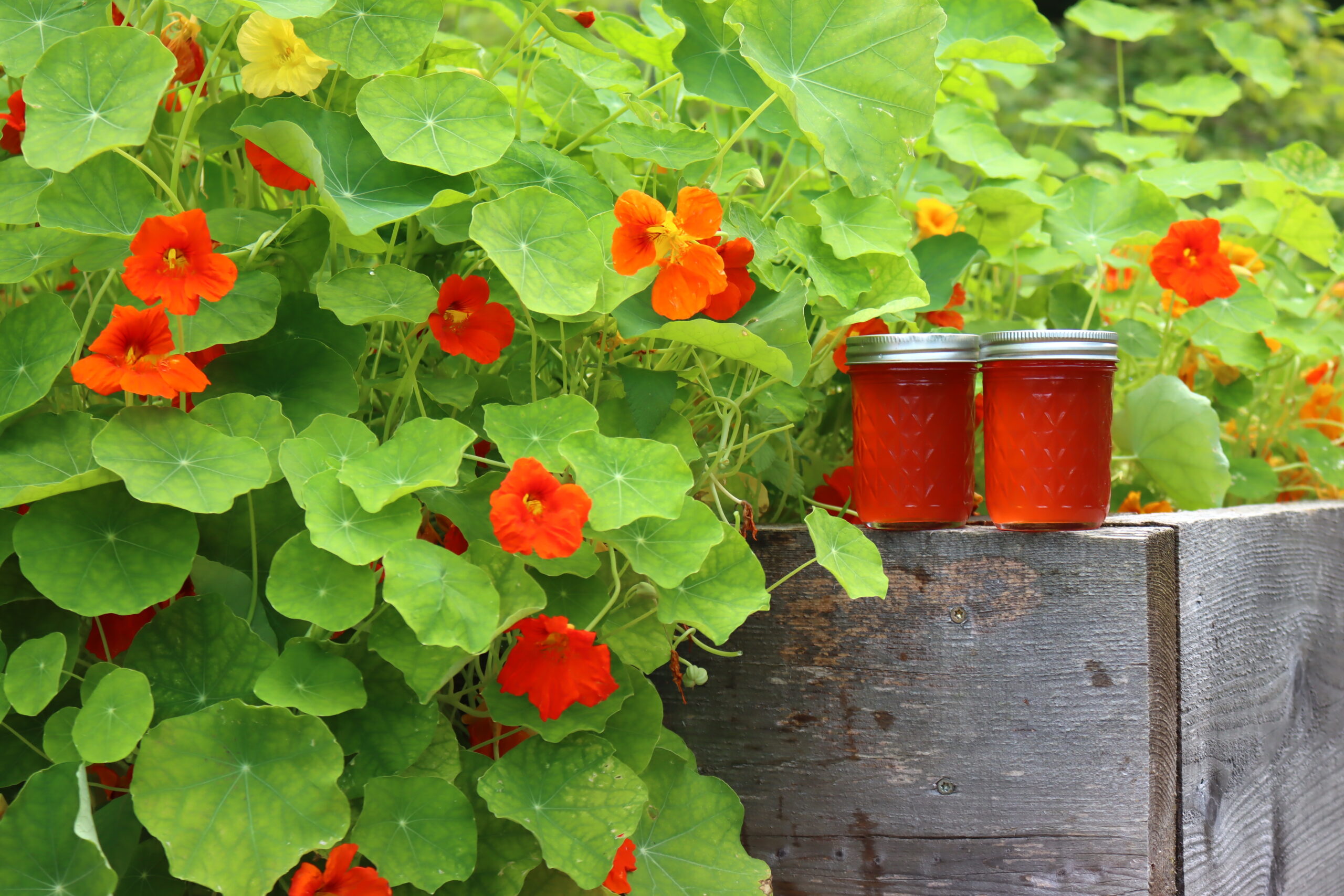
Naturtiums are delicious edible flowers, best known as brightly colored salad toppers, but also enjoyed as spicy snacks right out in the garden. We always plant a few nasturtiums each year because they bring all the pollinators to the yard, but this year, we planted a whole bed of them.
Every part of the plant is edible, and I was hoping to try my hand at making nasturtium pesto and nasturtium seed capers. The green leaves make a wonderful pesto, and the underripe green seeds are excellent pickled or lacto-fermented into homegrown capers. Actual capers sold in the grocery store are closely related to nasturtiums, so the flavor is surprisingly similar.
But what about the flowers?
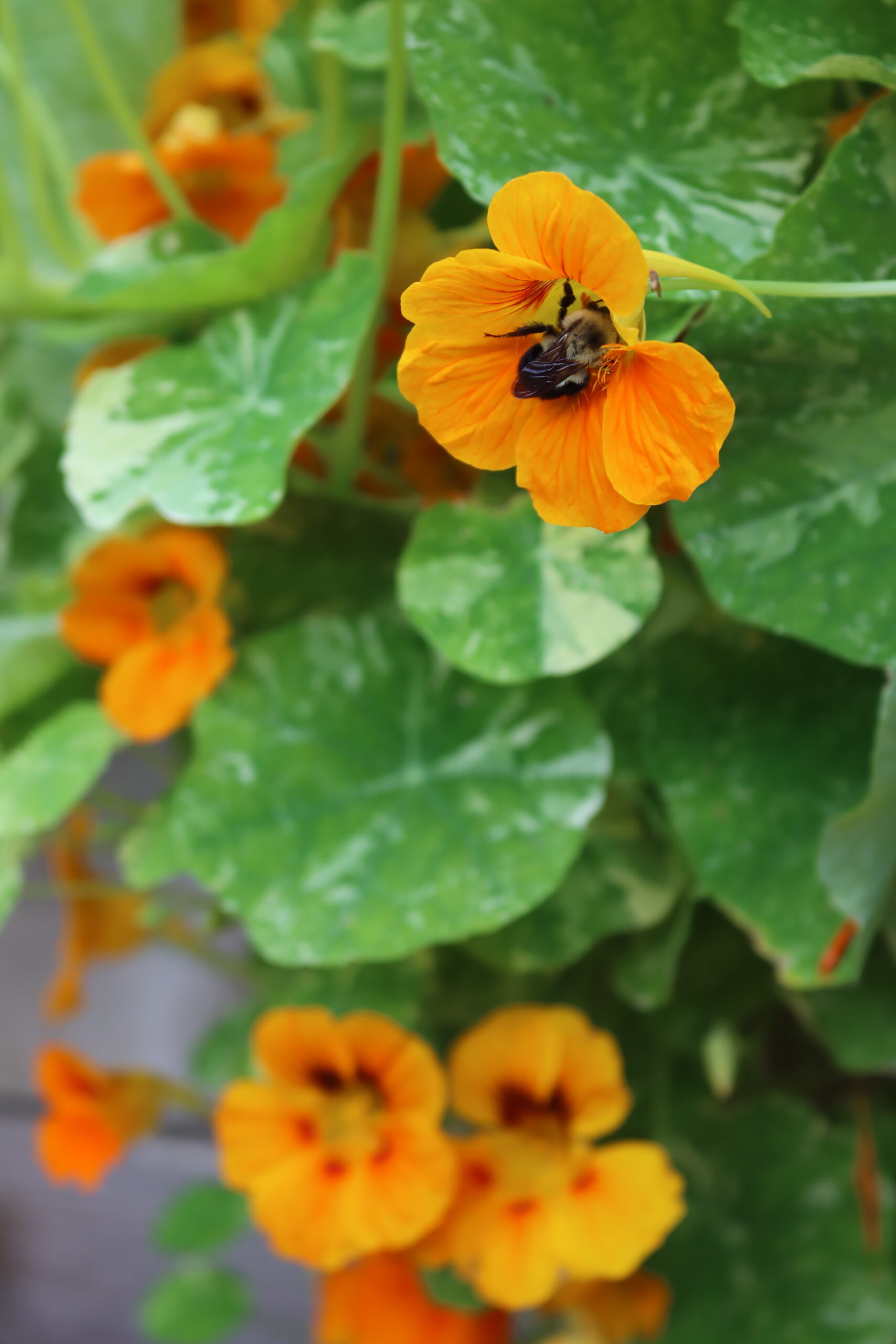
Those are the best-known edible parts, but they’re most often simply enjoyed raw in salads, and they rarely make it into more interesting dishes. I cooked a few up into stir-fries and added them to simmering pots of rice, both of which were excellent….but then I came across a recipe for nasturtium jelly in an old cookbook.
They have a spicy/sweet flavor that’s a bit like Sichuan peppercorns, and the author chose to play up the connection and made a jelly with a pinch of Sichuan added in for extra spice.
This nasturtium jelly can be made as is with just the flavorful flowers, or you can kick it up a notch and add other seasonings, the choice is yours.
What does Nasturtium Jelly Taste Like?
A jelly made from nasturtium flowers is both sweet and spicy and pairs well with neutral dishes like plain butter biscuits, where its unique flavor can really shine. It also compliments meats, where the jelly can be used as a glaze while the meat cooks.
It has a peppery flavor for sure, but there are also sweet and floral notes, making it a truly unique floral jelly.
I’ve written this recipe as a standard sweet jelly, but you can also use nasturtium flowers in my savory herbal jelly recipe.
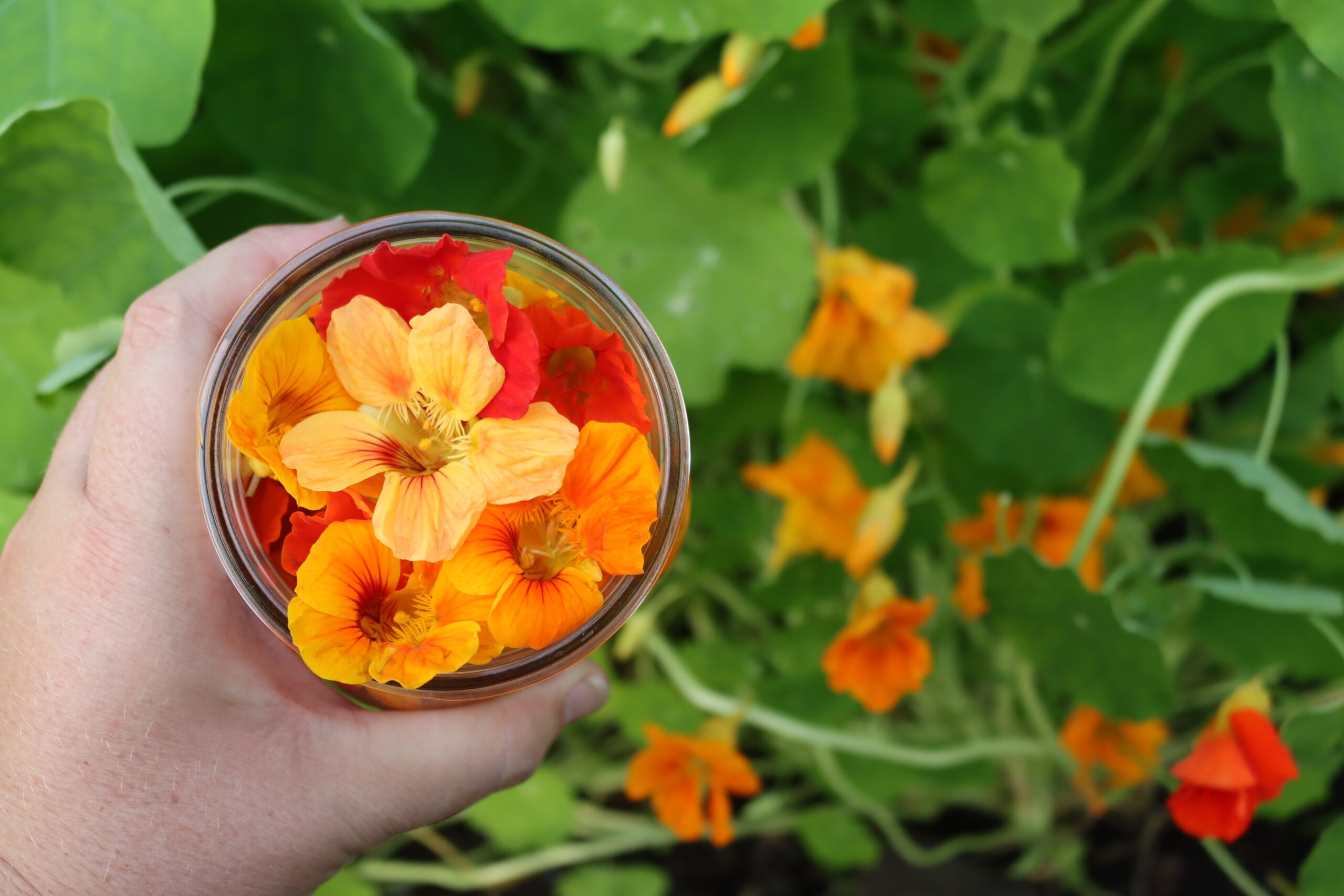
Harvesting Nasturtium For Flower Jelly
For a full batch of nasturitum jelly, you’ll need about a quart of nasturtium flowers. That seems like a lot, but these are incredibly prolific plants and you should be able to harvest that even from a single hanging basket once the plants are in peak bloom. If you’re short on flowers, you can make a half batch, or keep them in the refrigerator for a few days until more flowers emerge.
A single box of pectin is 6 Tbsp, so to make a half batch you’d just use 3 Tbsp and reserve the rest for other recipes.

Ingredients for Nasturtium Jelly
To make Nasturtium flower jelly, you’ll need fresh Nasturtium blooms, along with water, sugar, pectin, and a bit of lemon juice.
For a batch that makes 4 to 5 jars (8 oz each), gather the following:
- 4 cups of Nasturtium Flowers
- 4 cups of water
- 2 tbsp lemon juice (or ½ tsp citric acid)
- 1 to 4 cups of sugar *see note
- 1 box (1.75 oz) pectin (regular or low sugar)
Lemon juice plays a vital role in this recipe by balancing the sweetness of the sugar. It adds a slight tartness that enhances the flower flavor. Beyond flavor, it helps lower the pH, ensuring the pectin sets properly, and it preserves the jelly, making it safe for canning.
Even if you’re not planning to can the jelly, lemon juice is still necessary. For a more neutral flavor, citric acid (dissolved in a bit of water) can be substituted. Keep in mind that citric acid is stronger than lemon juice, so use ¼ teaspoon of citric acid for every tablespoon of lemon juice (or lime juice) in the recipe.
This recipe requires 2 tablespoons of lemon juice, so you’ll need ½ teaspoon of citric acid.
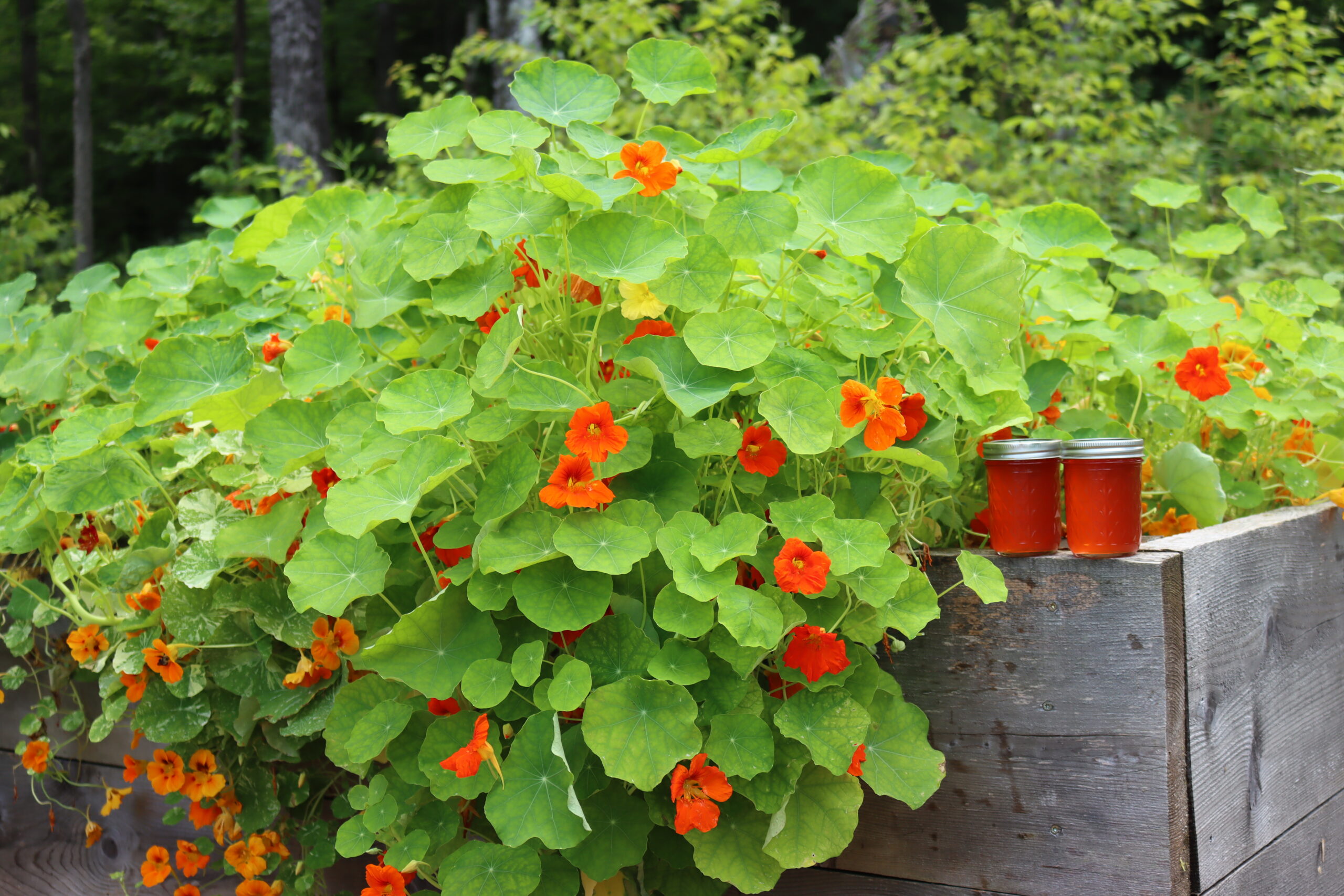
For pectin, I recommend using Sure-Jell or Sure-Jell low-sugar pectin, which I find reliable and give the best texture. (I’ve experimented with many types of pectin.) If using regular Sure-Jell, you’ll need at least 4 cups of sugar because it requires a 1:1 ratio of liquid to sugar to set properly. If you’re using Sure-Jell low-sugar pectin, you can use as little as ½ cup sugar for a barely sweet jelly. For a moderately sweet jelly, 1 to 2 cups of sugar should suffice.
(Sure-Jell low sugar works with both full-sugar and low-sugar recipes, which is why I usually keep it on hand.)
For those using Ball Flex Batch Pectin, 6 tablespoons is the equivalent of one 1.75 oz box of standard pectin.
The recipe card also provides instructions for using liquid pectin, but it requires a huge amount of sugar (7 cups sugar for 4 cups liquid). I don’t use it, but I’ve included it for those who prefer liquid pectin.
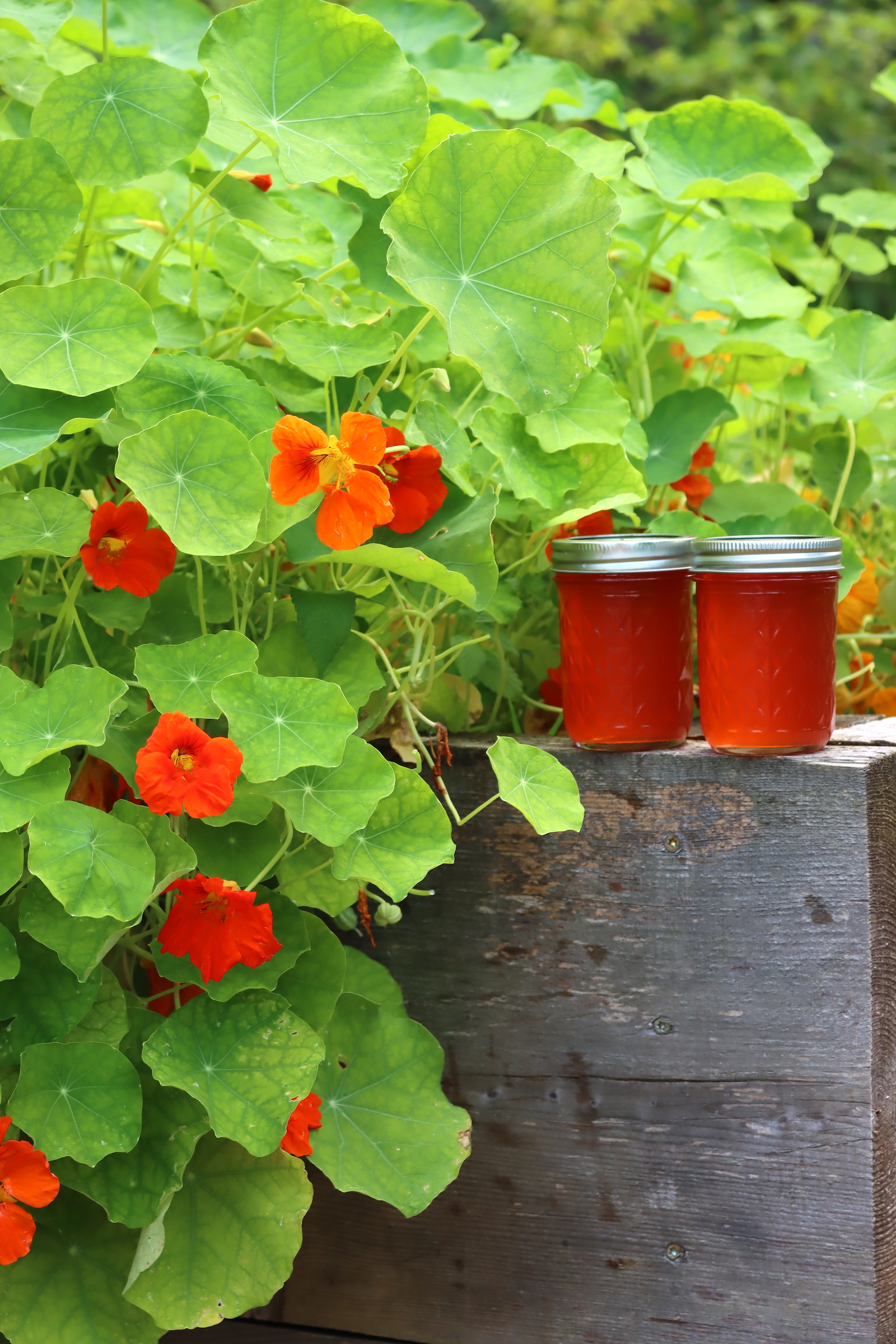
How to Make Nasturtium Jelly
Making jelly from Nasturtium flowers is similar to making any other flower jelly, with one difference—Nasturtiums have a strong, spicy flavor that will really shine through.
You’ll need about 2 to 4 cups of fresh Nasturtium flowers. I prefer picking them directly into a quart jar because it’s the perfect size for the next step, which involves steeping the flowers in 4 cups of boiling water.
Allow the Nasturtium flowers to steep for 15 to 20 minutes before straining the liquid.
Pour the flower tea into a jelly pot and add 2 tablespoons of lemon juice. The lemon juice is essential for balancing the sweetness of the sugar and ensuring the jelly is safe to can. I recommend using it even if you’re not canning your jelly. Bring the mixture to a boil.
Stir in one box of powdered pectin. (I typically use Sure-Jell, but any standard 1.75 oz box of pectin will work.)
Mix the pectin until it’s completely dissolved, and then let it boil for a full minute.
Now, add the sugar. Regular pectin needs a 1:1 ratio of sugar to liquid, so for 4 cups of Nasturtium tea, you’ll need 4 cups of sugar.
If you’re using low-sugar pectin, like Sure-Jell low sugar, you can use as little as ½ to 1 cup of sugar for a less sweet jelly.
Stir the sugar into the mixture until it’s completely dissolved, then return it to a hard boil for another minute.
After the minute has passed, remove the mixture from the heat and ladle it into prepared jelly jars, leaving ¼ inch of headspace.
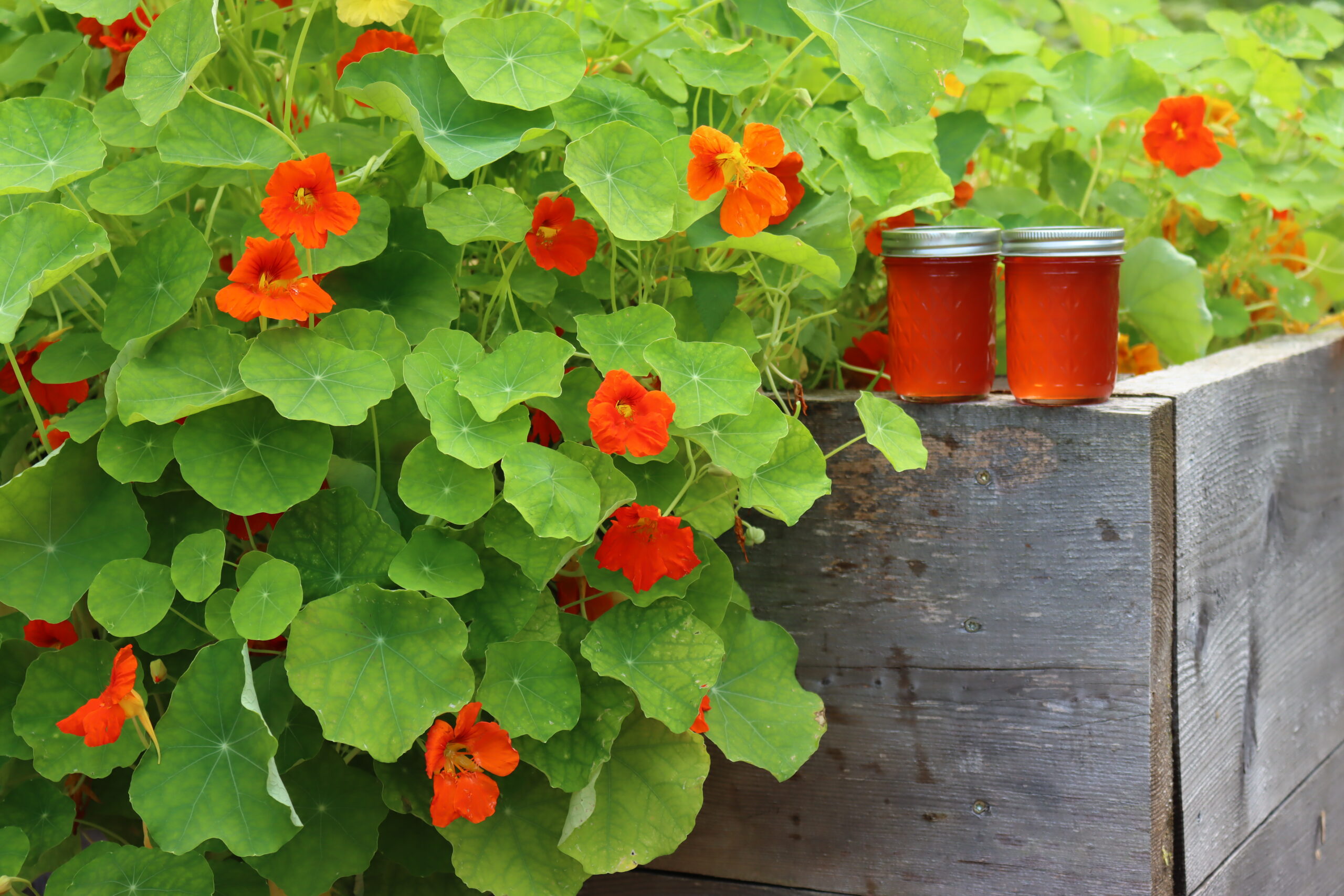
Canning Nasturtium Flower Jelly
Canning the jelly is optional, and you can simply store it in the refrigerator, where it will keep for several weeks. Alternatively, freezing the jelly is another option, as long as you’re using freezer-safe jars.
Personally, I prefer the ease of canning the jelly in a water bath canner because it allows me to store the jars in my pantry year-round. This way, I can enjoy the unique, spicy flavor of Nasturtium jelly any time without taking up refrigerator or freezer space.
If you plan to can, be sure to include the lemon juice, which lowers the pH to make the jelly safe for canning.
Before you begin, prepare your water bath canner, canning jars, and lids. Follow the recipe steps, then ladle the jelly into the jars, leaving ¼ inch of headspace.
Seal the jars with 2-part canning lids and process them in the water bath canner for 10 minutes. If you’re above 6,000 feet in elevation, increase the processing time to 15 minutes.
Once the canning time is done, remove the jars and let them cool on a towel on the counter. Properly sealed jars will last 12 to 18 months in a pantry. Be sure to refrigerate the jelly after opening.
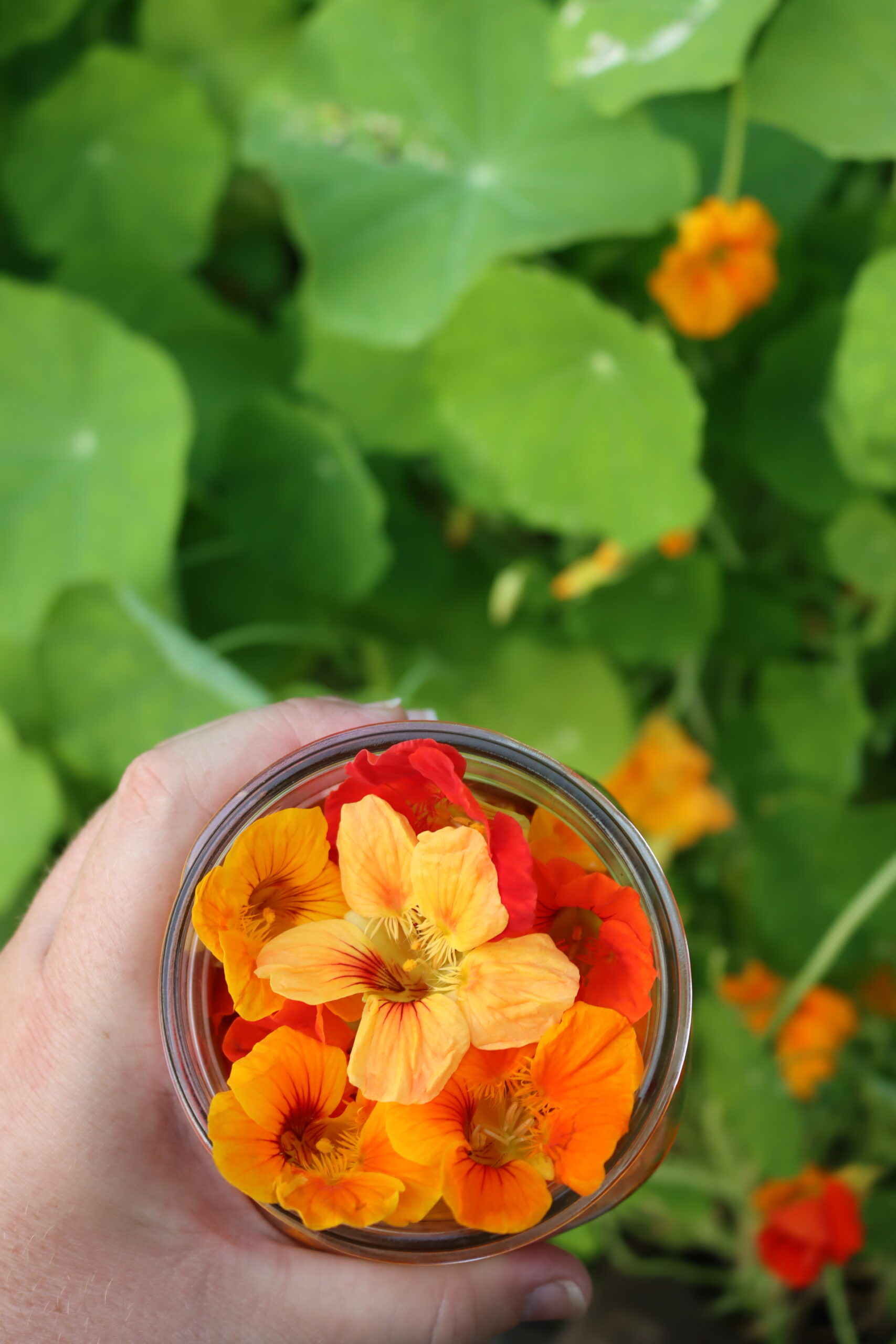
Nasturtium Jelly Variations
One recipe I came across used a Tablespoon of Sichuan peppercorns to flaunt the jelly, and the two tastes go remarkably well together. Try adding a bit of Sichuan peppercorns into the jar before you pour boiling water over the top. They’ll infuse into the floral tea and add a unique flavor to your homemade jelly.
I’ve written this recipe as a standard sweet jelly, but you can also use nasturtium flowers in my savory herbal jelly recipe.
Nasturtium Recipes
Looking for more ways to use Nastutium flowers?
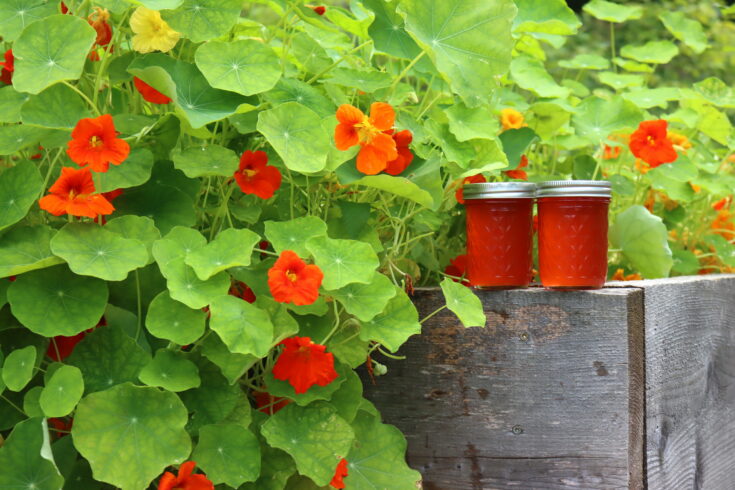
Nasturtium Jelly
Nasturtium jelly is a unique way to use these bright spicy flowers, and it makes an unforgettable floral jelly.
Ingredients
- 4 cups nasturtium flowers
- 4 cups water
- 2 tbsp lemon juice
- 1 to 4 cups sugar *see note
- 1 box (1.75 oz) pectin (Regular or Low Sugar)
Instructions
- Pick 4 cups of fresh nasturtium flowers, making sure to inspect them carefully for any insects, then rinse them briefly under cold water.
- Place the flowers into a bowl and pour 4 cups of boiling water over them. Let the flowers steep for about 10 to 15 minutes, allowing the tea to fully infuse.
- Once the tea is ready, strain it into a saucepan or jam pot. Stir in the lemon juice, which not only helps bring out the vibrant color of the jelly but also balances the sweetness and aids in setting the pectin. Additionally, the acidity from the lemon juice helps preserve the jelly, so it’s essential not to skip this step.
- Bring the mixture to a boil and stir in the powdered pectin, ensuring it dissolves completely. Let the mixture boil for a full minute before adding the sugar. (Important: Do not add the sugar before the pectin or at the same time, as this will prevent the jelly from setting properly.)
- After the pectin has dissolved, add the sugar, stirring until fully dissolved (refer to the sugar quantity note for preferences). Bring the mixture back to a rolling boil and let it boil for another minute before transferring it into sterilized jelly jars, leaving ¼ inch of headspace at the top.
- If you're canning the jelly, process the jars in a water bath canner for 10 minutes (or 15 minutes if you're over 6,000 feet in elevation). If not canning, allow the jars to cool completely on the counter before refrigerating them (for up to a month) or freezing them (for up to 6 months).
Notes
When using standard pectin, you need to maintain a 1:1 ratio of liquid to sugar. This means for every 4 cups of flower blossom tea, you’ll need at least 4 cups of sugar to get the jelly to set properly. This will give you a very sweet, traditional-style jelly. If you want to reduce the sugar content, switch to low-sugar pectin and follow the same process, but use less sugar. I recommend Sure-Jell Low Sugar Pectin, which has been reliable in my experience.
Keep in mind that reducing the sugar will also reduce the final yield, with a full-sugar recipe yielding about 5 half-pints.
If you’re using Pomona’s Universal Pectin, the method differs slightly. This two-part low-sugar pectin doesn't include citric acid like most other pectins, so you’ll need to increase the lemon juice to 1/2 cup (instead of the usual 2 tablespoons). Be sure to follow the specific instructions provided on the Pomona’s box for making mint jelly, as they work for other floral jellies too.
For liquid pectin, the process changes—add the sugar first, followed by the pectin. Liquid pectin also requires a significantly higher amount of sugar, usually 7 cups of sugar for 4 cups of liquid. While I personally don’t recommend liquid pectin due to the high sugar requirement, it will still work if that’s your preference.
Lastly, if you’re using Ball Flex Batch Pectin, you’ll need 6 tablespoons (equivalent to a 1.75 oz box of other pectin varieties). This amount works for both their regular and low-sugar pectin products.
Flower Jelly Recipes
Stock your pantry with these tasty floral jellies!
Herbal Jellies
Flowers aren’t the only plants in the garden that make wonderful jellies!
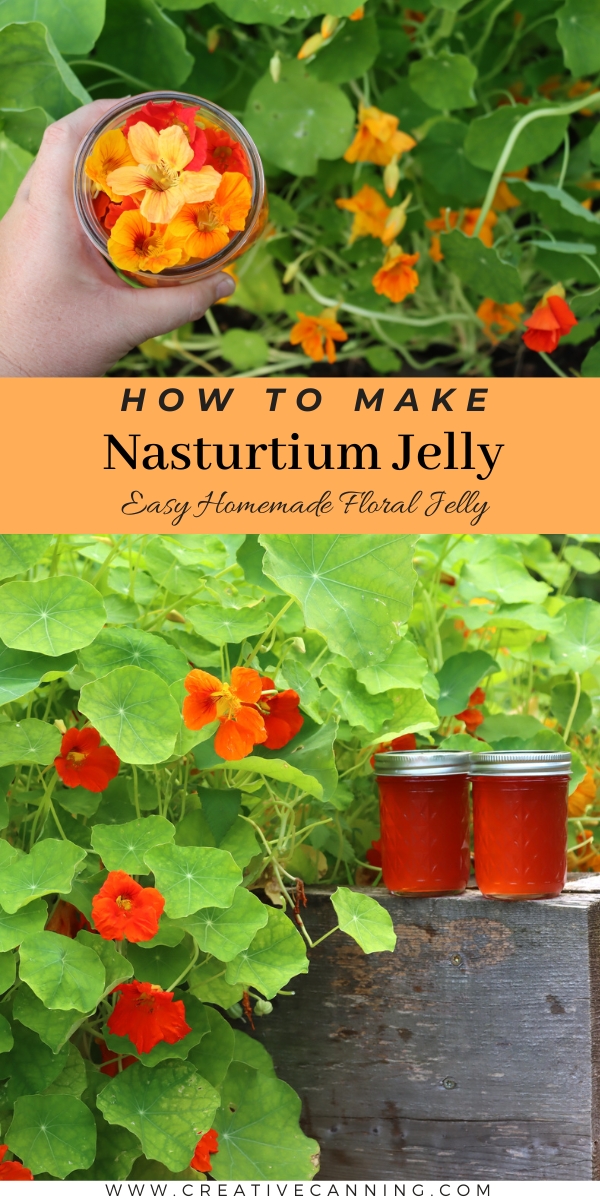
Leave a Reply